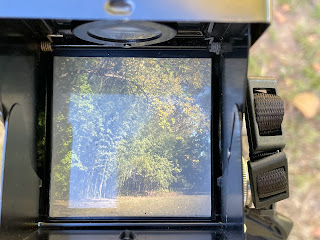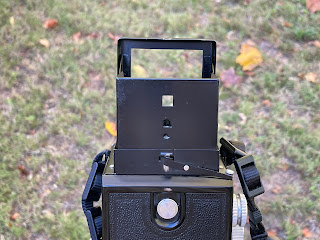A twin lens reflex camera has a taking lens to focus the image on film and matching viewing lens to focus the image on a ground glass focusing screen. The rays of light from the viewing lens are reflected straight up by a diagonal mirror to make an image on the horizontal ground glass. The lenses are synchronized so that the image on the film will be in focus when the image on the ground glass is in focus. The image on the ground glass is upright, but reversed left for right.
Twin lens reflex cameras using 120 film were first produced in Germany prior to WWII, when Francke and Heideke's Rolleiflex established the basic layout of the medium format twin lens reflex camera. The war interrupted camera exports from Germany in 1939, giving US camera manufacturers the opportunity to fill that segment of the camera market. Ciro, Inc. was one of the first to make a TLR, bringing out the Ciro-flex twin lens reflex camera in 1940. The Franco-American engineer and inventor Rodolphe Stahl started Ciro in Detroit, Michigan, and relocated to Delaware, Ohio, after the Second World War. The entire camera line was sold to Graflex, Inc. in 1951 and production was moved to Rochester, NY. Graflex renamed the Ciro-flex the Graflex 22, making a few minor changes but keeping the same basic design. Graflex discontinued twin lens reflex cameras in 1956.
The original Ciro-Flex had an uncoated f/3.5-f/22 85mm Wollensak Velostigmat taking lens and an f/3.2 85mm anastigmat viewing lens. The shutter was a Wollensak Alphax with speeds from 1/200 second to 1/10 second. It was not synchronized for flash. The taking and viewing lenses had three elements in three groups. The camera had black leatherette and black enamel finish. The camera was discontinued when Ciro switched to war production in 1942.
The post-WWII model B had specifications similar to the pre-WWII model. The taking lens was an f/3.5-22 85mm Wollensak Velostigmat with anti-reflection coatings ("Wocote") and the shutter was a Wollensak Alphax. All of the post-WWII Ciro-flexes had coated lenses.
The model C had a Wollensak f/3.5-f/22 Anastigmat taking lens and a 1/400 second to 1 second Rapax shutter but was otherwise the same as the model B.
The model D was the same as the model B with the addition of flash synchronization. The flash synchronizer had a built-in 20 millisecond delay. The designation of the taking lens was changed from Velostigmat to Anastigmat. As far as I know the lens design wasn't changed, only the name.
The model E was the same as the model C with the addition of flash synchronization. The flash synchronizer had a built-in 20 millisecond delay.
The model F had an f/3.2 83mm Raptar taking lens (a Tessar type with four elements in three groups) and a Synchromatic Rapax (1/400 to 1 second) shutter with a variable delay (5 milliseconds to 20 milliseconds) synchronizer for flash.
The later cameras had fresnel field lenses under the ground glass. The field lenses corrected for the light fall-off on the corners of a plain ground glass.
After Graflex took over production there were a number of other changes. The models B and C were dropped. The Ciro-flex model D was made with little change until it became the Graflex 22 model 200 with some mostly cosmetic changes. The model E likewise continued for a while until it was renamed the Graflex 22 model 400. The model F became the Graflex 22 model 400F. The names on the shutters were changed on the Graflex 22 models from Alphax to Century, and from Rapax to Graphex. Graflex had already used the Century and Graphex names for Wollensak shutters on the Graphic series of press cameras. Graflex adopted a gray color scheme for the Graflex 22 TLRs. The rotating cover on the ruby window was changed to a sliding cover. A hot shoe for flash replaced the ASA bayonet. The second tripod socket on the side was removed.
This example is a Ciro-Flex model C with a coated f/3.5-f/22 85mm Wollensak Anastigmat in a Wollensak Rapax shutter. Shutter speeds are 1/400, 1/200, 1/100, 1/50, 1/25, 1/10, 1/5, 1/2 and 1 second plus bulb and time. The Rapax shutter has separate set and release levers. Generally, on a leaf shutter you want to the the shutter speed before you cock the shutter.
The photographer needs to look through the little red window at the numbers printed on the backing paper of the film to count exposures and space the pictures. You open the shutter under the red window, wind the film to the next number, and close the cover to help prevent stray light entering the red wind and fogging the film. There is no interlock to prevent double exposures or skipped pictures. The numbers on the backing paper for Kodak and Ilford film are faintly printed and are a little harder to see through the red window than the numbers on the backing paper for Arista.EDU Ultra film, which has numbers in bold print. Picture size is 2-1/4" (57mm) square. There are 12 pictures on a roll of 120 film (still available today).
To focus and compose your picture you open the hood at the top of the camera and look down onto the ground glass screen. The focusing screen is the same size as the negative, as usual with a twin lens reflex camera. The focusing screen has a fresnel field lens to improve the image brightness in the corners of the viewfinder. A flip up magnifier is there to enlarge the image for critical focusing. For fast action shots you would open the sports finder on the front of the hood and zone focus the camera.
A new model C listed for $99.45 in 1950, equivalent to about $1,000 in depreciated 2018 dollars. The camera I have still takes a decent picture.
This picture of two readers on a bench at Sally Beaman Park, Nashville, TN, next to the Green Hills branch of the Nashville Public Library was taken with the Ciro-flex C and Kodak Ektar 100 film.
This is a Ciro-flex model F twin reflex camera made just after Graflex took over the Ciro-flex line and while it was still using the Ciro-flex name. The camera body is formed from steel finished in black enamel paint with black leatherette and chrome knobs. It has the typical twin lens reflex camera configuration. 1/4"-20 tripod sockets are on the bottom and the left side. It weighs 2 lb. 5 oz. (1.05 kg) with a roll of film inside.
Normally the camera is held chest high so you look down at an image of the scene on the ground glass viewing and focusing screen. The image appears upright, but is reversed left to right. The camera focuses by moving the lens board. The viewing lens and the taking lens move together so that an image in focus on the ground glass will be in focus on the film. A fresnel lens under the focusing screen corrects some of the fall off of light in the corners that you get with a plain ground glass. There is a flip-up magnifying glass to help focus the camera. A folding hood shields the ground glass from stray light, but the image can still be difficult to see in bright sunlight. A lever on the back pops up the hood. The front of the hood folds back to make an open frame sports finder that you can look through with the camera held at eye level. The sports finder is useful when you try to follow fast action.
The focusing knob has distance and depth of field scales for zone focusing. The depth of field scale is based on a 0.066 mm circle of confusion.
The taking lens is a coated, f/3.2-f/22, 83mm, Wollensak Raptar lens. The lens is a Tessar type with four elements in three groups. It uses 1-5/16" (33mm) Series VI filter adapters.

The shutter is a set and release Wollensak Rapax Synchromatic shutter. The shutter has a speed ring that can be set to 1/400, 1/200, 1/100, 1/50, 1/25, 1/10, 1/5, 1/2 or 1 second, "B" for bulb or "T" for time. A socket for a standard cable release is provided. The flash synchronizer lever can be set to off (no flash), X-F (electronic flash or 5 millisecond delay flash bulbs) or M (20 millisecond delay flash bulbs). The shutter speed ring and the synchronizer lever should be set before the shutter is cocked. The synchronizer settings and shutter speeds are color coded. The black synchronizer settings are used with the black shutter speeds and the red synchronizer settings are used with the red shutter speeds. The flash connection is an ASA standard bayonet on the side of the camera. If you want to use a modern electronic flash you will need to find an ASA bayonet to PC sync connection adapter.

The camera takes size 120 roll film. To load film you open the back by pushing down the knob located near the top edge, putting the fresh film in the chamber at the bottom and threading the backing paper into the take up spool at the top. You close the back and turn the film winding knob until you see the number 1 in the red window, which puts the first section of film in position for taking a picture. The red window has a cover to prevent stray light from fogging the film. You open the cover while advancing the film and close it after the film is in position for the next picture. Because the camera does not have an automatic film counter, you space the pictures on the film by looking through the the red window at the numbers on the film. The film advance and the shutter are not interlocked. Accidental double exposures or skipped frames are possible. Graflex recommended advancing the film immediately after taking a picture. When all 12 pictures have been taken, you wind the roll completely onto the take up spool, remove the exposed roll from the camera and seal the roll. You then move the empty spool from the bottom to the top to be ready for reloading.
 |
|
This picture of a fisherman was taken from Lock Two Park, Nashville, Tennessee, looking across the Cumberland River in the direction of the mouth of Gibson Creek. The park is the site of a navigation lock built by the US Army Corps of Engineers in 1892-1907. The purpose of the dam and lock was to allow the passage of steamboats over a shallow part of the river. The old dams and navigation locks on the Cumberland were replaced by larger and more modern dams and locks after the Second World War. The dam and most of the lock at this location were removed about 1956. Only the lock wall on the land side is visible.
The Model F is fairly easy to use. The image on the ground glass screen can be a little difficult to see in bright sunlight. The lens is reasonably sharp.












No comments:
Post a Comment